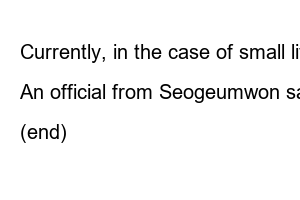소액 생계비대출In addition to the analysis that young people’s financial situation has become difficult to the extent that interest, which is less than 10,000 won per month on average, is burdensome, there are also criticisms that the government is increasing side effects by granting loans without considering the ability to repay.
◇The non-payment rate of interest for people in their 20s is the highest at 28%… struggling with debt
According to data submitted by Oh Ki-hyung, a member of the National Assembly’s Political Affairs Committee, from the Korea Inclusive Finance Agency (Seogeumwon) on the 5th, the rate of non-payment of interest on small living expenses loans for people in their 20s or younger (ages 19 to 29) is 27.4% (as of September 5). As a result, one in four people were unable to pay interest on time.
The non-payment rate of interest on small loans for living expenses among people in their 30s is 19.8%, which is close to 50% when combined with the rate of non-payment of interest on loans for people in their 20s and 30s.
The rate of non-payment of interest on small loans for living expenses among those in their 40s was 15.4%, followed by those in their 50s at 11.6%, those in their 60s at 8.9%, and those in their 70s and older at 9.3%.
The small living expenses loan is a service that provides cash loans up to 1 million won to adults with a credit score in the bottom 20% and an annual income of 35 million won or less.
If you pay the interest faithfully for more than 6 months after the initial loan of 500,000 won, an additional 500,000 won will be loaned. It was created with the purpose of providing emergency funds to people with low credit who are prone to illegal private financing.
Even considering that it is a system that attracts vulnerable borrowers who cannot use institutional finance, there are quite a few people in their 20s who are unable to properly repay even an amount of less than 10,000 won per month.
The reasons why people in their 20s struggle with the burden of debt are complex.
Due to the nature of people in their 20s, many people do not have stable jobs, and the fact that quality jobs for young people are decreasing seems to have had a direct impact.
In fact, according to the ‘August Employment Trends’ announced by Statistics Korea on the 13th of last month, the number of employed young people under the age of 29 decreased by 103,000 compared to August last year. The number of people employed more than 36 hours, which are classified as full-time jobs, also decreased by 1 million. This is the largest decrease since the decrease of 2.794 million in October last year.
In a situation where jobs and income are unstable, the burden of living expenses on young people has also increased due to high inflation and high interest rates.
According to the ‘Financial Stability Report’ released by the Bank of Korea on the 26th of last month, household loans per person among young people in their 30s or younger in the second quarter of this year were 79.27 million won, an increase of 27.0% compared to the second quarter of 2019 (62.44 million won).
Compared to income, the youth group increased their household loans at the fastest rate. The debt-to-income (household loan + individual business loan) burden ratio of young borrowers was 262%, up 39 percentage points (p) compared to the fourth quarter of 2019 (223%). During the same period, it outpaced the increase in the middle-aged group (35%p) and the elderly group (16%p).
Another problem is that the delinquency rate has recently been rising, especially among vulnerable young borrowers. The overall delinquency rate for young people in the second quarter of this year was 0.58%, which was lower than that of other age groups (0.81%), but the delinquency rate for vulnerable borrowers was 8.41%, an increase of more than 3 percentage points compared to two years ago (5.39%).
◇Only eligibility screening is applied to loan repayment management… The authorities gave up
As the credit risk of borrowers in their 20s, whose income base is somewhat weaker than that of other age groups, increases, some point out that even if it is a policy finance product for vulnerable borrowers, careful management of insolvency is necessary.
Rather than simply supplying low-income financial products, institutional supplementation must be provided to improve the debt structure of vulnerable young borrowers and help them achieve economic independence in the long term.
Currently, in the case of small living expenses loans, as they were introduced to provide breathing room for vulnerable groups who were unable to cross the threshold of the financial sector due to delinquency or low credit scores, they are eligible for loan screening rather than the Credit Scoring Model (CSS) that verifies borrowers’ ability to repay loans. Only judge whether or not.
In addition, the government’s position is that there is no room for the government to actively manage the receivables, as it is not currently overdue on the principal but rather ‘unpaid interest’ due to the grace period.
An official from Seogeumwon said, “It is true that the non-payment rate of interest on loans for small living expenses among people in their 20s is high, but since they are not currently overdue on principal repayment (after the grace period ends), there are actions that can only be taken if the payment is overdue.” “Because the principal repayment grace period is one year, we are strengthening counseling and education when handling new loans,” he explained.
This official said, “Since this product does not have a separate CSS evaluation like the general Sunshine Loan, we expected to some extent that the non-payment rate would be relatively high, and we are strengthening financial education internally for additional management.”
(end)

